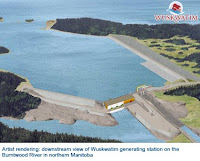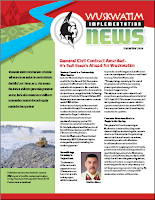David Anton Jacks
Reprinted from The Banana Peel
I've been following some of the stories about the Wuskawatim blockade, and once again, mainstream media has created a situation where the story is about a group of protesters, rather than the core, underlying issues faced by many Aboriginal people in Manitoba: Poverty, systemic discrimination, and the consistent denial of self-determination.
So I decided to do a little research. :p
On August 14, 2009, nearly three dozen protesters from Nisichawayasihk Cree Nation blockaded a road leading to the Wuskwatim Hydro Dam in Northern Manitoba, stating that "there were not enough Aboriginals who have been hired."

Amitai Etzmioni states in Demonstration Democracy that:
“Demonstrations… are a particularly effective mode of political expression in an age of television, for underprivileged groups, and for prodding stalemated bureaucracies into taking necessary actions. Indeed, demonstrations are becoming part of the daily routine of our democracy and its most distinctive mark.”
For those of us who recall the March, 2008 protests at City Hall, it was no coincidence that one protester’s placard garnered more media attention than the purpose of the protest: that Mayor Katz’s continued freeze on property tax would damage the City’s infrastructure and services, and discussions on the potential development of P3s.
In fact, like Friday’s reactions to the Wuskwatim protest where the Winnipeg Free Press labels them as “rebels and renegades”, City Councilor Lazarenko (who consistently labels demonstrators as “fear mongers”) stated that:
"It gets to be like a mini-riot. It comes to a point where we lose control"
(CBC, March 2008)
(note that the demonstrator sincerely apologized for the apparent misguided judgment- or the misinterpretation of his message, and that the entire demonstration was peaceful).
Up at Wuskwatim, we see a similar situation of reporting at face-value.
But what exactly is the media conveniently ignoring?
In 1973 a report entitled “Wahbung: Our Tomorrows” was authored by The Indian Tribes of Manitoba outlining the dire need for justice for Aboriginal Manitobans who suffered under absolute poverty, lack of potable water, inadequate health and education facilities and a discriminatory justice system.
Most notably Wahbung sought the modest goal to ensure that:
“First Nation economic, social, and educational development are interrelated and must develop uniformly”
Yet thirty years later, the Assembly of Manitoba Chiefs (AMC) noted that:
“Unfortunately, First Nation self-sufficiency as envisioned in Wahbung has yet to become a reality. The socio-economic conditions of the First Nations remain far below national standards.”
The United Nations Declaration on the Rights of Indigenous Peoples notes:
Article 26. 1. Indigenous peoples have the right to own, use, develop and control the lands, territories and resources that they possess by reason of traditional ownership or other traditional occupation or use, as well as those which they have otherwise acquired.
While this document was adopted on September 13, 2007, the only four nations which voted in opposition were Australia, New Zealand, the United States and Canada: The four Nations with the largest indigenous populations in the world.
This attitude from Canadian leaders has been a slap in the face to Aboriginal peoples in Canada, and has shown that Canada is not willing to be a leader, despite the vision and encouragement from the rest of the world.
What does any of this have to do with the Wuskwatim demonstrations?
With a poverty rate of a staggering 29%, in Aboriginal communities in Manitoba, AMC’s statement certainly stands ground.
Nisichawayasihk Cree Nation (NCN), the nearest First Nations reserve to the Wuskwatim Hydro project (and the community in which the demonstrators are from) has had an interesting history.
To begin, the relationship between Hydro projects and NCN is already one-sided and counter to Treaty and Land Claim Rights, let alone the international vision of the UN Declaration.

During the 1960s and 1970s, as Manitoba Hydro began developments in Northern Manitoba, NCN lands were severely flooded and the people of Nisichawayasihk were forcibly relocated.Many residents ended up in an exodus-like situation, moving to Winnipeg and other urban centres..
This type of forcible relocation can damage a community for decades. NCN has a population of about 2000 people (4,200 if you include those in Winnipeg, Thomson etc.). This is similar to forcibly relocating 2/3 of Virden or Altona, or 1/3 of Wolseley in Winnipeg to a location over 50 kilometers away.
The community of NCN negotiated with Manitoba Hyrdo to hold a 33% share in ownership of the Wuskwatim project- a minority share. Manitoba Hydro spokesman Glenn Schneider says that the Wuskwatim Dam currently has 230 Aboriginal employees out of 800, yet only 44 workers are from Nisichawayasihk (33% of 800 employees is 352). He also states in the Winnipeg Sun that:
"Obviously we're having some success in hiring aboriginals generally," and "They were never guaranteed a specific number of jobs, or one-third of the jobs, or anything like that."
Its no wonder that the demonstrators (who are also part of the 33% ownership) are upset.
To make matters worse, in a move against First Nations’ right to self-governance and autonomy, Manitoba Hydro has imposed a system whereby NCN residents who wish to work at the Wuskwatim Dam site (in which they own 33%) must now apply through The Government of Manitoba Job Referral Service, a confusing mesh of application forms, and wait lists.
In fact, the July edition of the Wuskwatim Implementation News , distributed throughout NCN noted that:
“If applicants do not provide frequent follow-ups with the JRS, their applications can become inactive.”
Yet, despite the issues above, the actions of the “renegade group” should not come as a surprise. The July, 2009 Wuskwatim Implementation News notes that:

“There have been concerns raised by NCN Citizens about the Job Referral Service system and how it is working.”
And then, there are those who have commented on the media sites, outlining that Aboriginal demonstrators who want to work at the Dam should upgrade their education and skills so they are hired “fairly”, rather than to complain about it.
Once again, if we look at the underlying issue, it’s not difficult to understand the Catch-22 situation that many Aboriginal people are forced into.
Currently, only 5% of Aboriginal people in Manitoba have post-secondary training, compared to over 15% of the total population, and its not for lack of trying.
According to the Assembly of Manitoba Chiefs, there are over 1,000 potential Aboriginal students on wait lists to access the Treaty-right funding from the Federal government, along with 9,000 Aboriginal students across Canada.
But even when you go to the Wuskwatim/Hydro/Manitoba government Job Referral Service website, you’ll find that the Aboriginal Training Resources link leads you to an "ERROR” screen.
It is clear that this issue is not simply about employment; its about discrimination, a history of oppression and consistent failure to acknowledge Aboriginal rights to self-determination, land, education and entitlement.
Canada’s consistent failure to uphold the legally binding Treaty Rights of Aboriginal people from coast-to-coast has continued the system of oppression and misunderstanding that has forced far too many people into poverty, and has been likened to Canada’s own system of Apartheid.
Amitai Etzmioni was right in saying that demonstrations are ways for underprivileged groups to express themselves to government.
Its time that we address the issues that force people into situations of being “underprivileged”, and start taking action to better all of our lives.
The demonstrators at Wuskwatim, whether they know it or not, are doing just that.









No comments:
Post a Comment